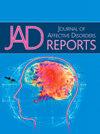Individual differences in anxious apprehension and anxious arousal alter resting-state network structure and connectivity
Q3 Psychology
引用次数: 0
Abstract
Background
Pathological anxiety is commonly treated as a unitary construct, manifesting as various clinical subtypes. However, there is a growing consensus that anxiety has at least two unique dimensions, anxious arousal and anxious apprehension. Nevertheless, their distinguishable neurobiological mechanisms are unclear. Here, we take a transdiagnostic approach to disentangle network-level functional and structural disturbances at rest, a state when some anxiety symptoms may be most apparent.
Methods
53 adults experiencing a range of anxiety and/or depressive symptoms completed resting-state fMRI. Resting-state networks were identified by independent components analysis. Dual-regression tested anxious arousal and anxious apprehension derived within-network connectivity differences while controlling for depression. FSLNets tested differences in between-network functional connectivity.
Results
Anxious apprehension was associated with expansion of the default and somatomotor networks, while anxious arousal was associated with hyperconnectivity in the salience, limbic, frontoparietal, and default networks. Anxious apprehension was also associated with increased connectivity between the default and salience networks as well as decreased connectivity between the dorsal attention and limbic networks.
Limitations
Evaluating a larger sample size and longer resting-state scans can better ensure reproducibility of results. The cross-sectional design limits conclusions about the temporal dynamics of anxious apprehension and anxious arousal and functional connectivity alterations observed in the present study.
Conclusions
Results suggest that anxious apprehension and anxious arousal have distinguishable neurobiological mechanisms that contribute to maladaptive differences in threat evaluation, stress response, and self-referential thought. These findings enhance our understanding of anxiety's nosology and pathophysiology, informing potential mechanisms for intervention.
焦虑不安和焦虑唤醒的个体差异会改变静息态网络结构和连通性
病理性焦虑通常被视为一个统一的结构,表现为各种临床亚型。然而,越来越多的人认为焦虑至少有两个独特的维度,焦虑唤醒和焦虑忧虑。然而,它们可区分的神经生物学机制尚不清楚。在这里,我们采用一种跨诊断的方法来解开网络水平的功能和结构紊乱在休息状态,当一些焦虑症状可能是最明显的。方法对53名出现一系列焦虑和/或抑郁症状的成年人进行静息状态功能磁共振成像。静息状态网络通过独立分量分析进行识别。双回归测试了焦虑唤醒和焦虑理解在控制抑郁的情况下产生的网络内连接差异。FSLNets测试了网络间功能连接的差异。结果焦虑忧虑与默认网络和躯体运动网络的扩张有关,而焦虑唤醒与显著网络、边缘网络、额顶叶网络和默认网络的超连通性有关。焦虑焦虑还与默认网络和突出网络之间的连通性增加以及背侧注意网络和边缘网络之间的连通性减少有关。局限性评估更大的样本量和更长的静息状态扫描可以更好地确保结果的再现性。横断面设计限制了本研究中观察到的关于焦虑理解和焦虑唤醒的时间动态和功能连接改变的结论。结论焦虑理解和焦虑唤醒在威胁评估、应激反应和自我参照思维方面存在不同的神经生物学机制。这些发现增强了我们对焦虑的分类学和病理生理学的理解,为潜在的干预机制提供了信息。
本文章由计算机程序翻译,如有差异,请以英文原文为准。
求助全文
约1分钟内获得全文
求助全文
来源期刊

Journal of Affective Disorders Reports
Psychology-Clinical Psychology
CiteScore
3.80
自引率
0.00%
发文量
137
审稿时长
134 days
 求助内容:
求助内容: 应助结果提醒方式:
应助结果提醒方式:


